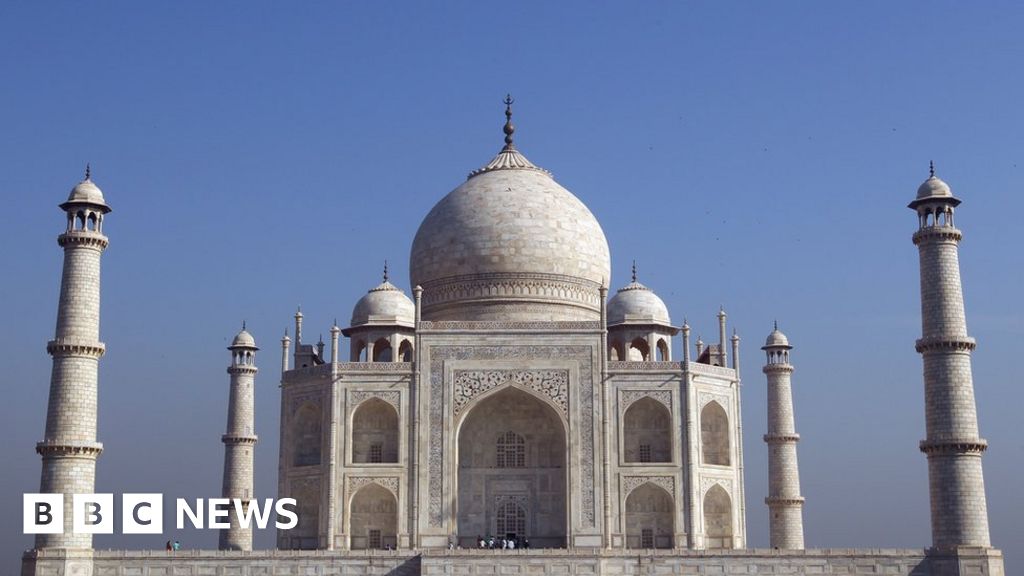Taj Mahal The True Story
Taj Mahal (India) Show map of India Cultural: i Reference Inscription 1983 (7th ) The Taj Mahal (;: ताज महल, meaning 'Crown of the Palaces') is an ivory-white marble on the south bank of the river in the Indian city of. It was commissioned in 1632 by the, (reigned from 1628 to 1658), to house the of his favourite wife,. It also houses the tomb of Shah Jahan, the builder.
The tomb is the centerpiece of a 17-hectare (42-acre) complex, which includes a and a guest house, and is set in formal gardens bounded on three sides by a wall. Construction of the mausoleum was essentially completed in 1643 but work continued on other phases of the project for another 10 years. The Taj Mahal complex is believed to have been completed in its entirety in 1653 at a cost estimated at the time to be around 32 million, which in 2015 would be approximately 52.8 billion rupees (827 million). The construction project employed some 20,000 artisans under the guidance of a board of architects led by the court architect to the emperor,. The Taj Mahal was designated as a in 1983 for being 'the jewel of Muslim art in India and one of the universally admired masterpieces of the world's heritage'. It is regarded by many as the best example of and a symbol of India's rich history. The Taj Mahal attracts 7–8 million visitors a year and in 2007, it was declared a winner of the (2000–2007) initiative.
Contents • • • • • • • • • • • • • • • • • • Inspiration The Taj Mahal was commissioned by in 1631, to be built in the memory of his wife, a princess who died giving birth to their 14th child,. Construction started in 1632, and the mausoleum was completed in 1643, while the surrounding buildings and garden were finished five years later. The imperial court documenting Shah Jahan's grief after the death of illustrates the love story held as the inspiration for the Taj Mahal.
The True Story of the Taj Mahal. This article by P. Oak (from Pune, India) provides an overview of his research and lists his 109 proofs of how the Taj Mahal was a pre-existing Hindu temple palace, built not by Shah Jahan but originally at least 500 years earlier in 1155 AD by Raja Paramardi Dev as a Vedic temple.
Us constitution document download pdf. Version 1.9.2 may include Send email button to facilitate emailing notes or annotations to colleagues or collaborators.
Architecture and design. Artistic depiction of Tomb The tomb is the central focus of the entire complex of the Taj Mahal. It is a large, white marble structure standing on a square and consists of a symmetrical building with an (an arch-shaped doorway) topped by a large dome. Like most Mughal tombs, the basic elements are Persian in origin. The base structure is a large multi-chambered cube with corners forming an unequal eight-sided structure that is approximately 55 metres (180 ft) on each of the four long sides. Each side of the iwan is framed with a huge or vaulted archway with two similarly shaped arched balconies stacked on either side.
Various types of heating are available for Miele Cooktops. Miele offers the right cooktop for every cooking preference. Find out more about induction heating here. View and Download Miele CERAMIC COOKTOP WITH INDUCTION KM 5753 operating and installation instructions online. Ceramic Cooktop with Induction. CERAMIC COOKTOP WITH INDUCTION KM 5753 Cooktop pdf manual download. Also for: Ceramic cooktop with induction km 5758, Km 5758. IMPORTANT SAFETY INSTRUCTIONS 4 When using the cooktop, follow basic safety precautions, including the fol‐ lowing: Read all instructions before installation and use of the appliance to prevent accidents and machine damage. This cooktop conforms to current safety requirements. Improper use can, however, lead to personal injury and damage to property. Miele induction cooktop instructions.
This motif of stacked pishtaqs is replicated on the chamfered corner areas, making the design completely symmetrical on all sides of the building. Four minarets frame the tomb, one at each corner of the plinth facing the chamfered corners.

The main chamber houses the false of Mumtaz Mahal and Shah Jahan; the actual graves are at a lower level. Main marble dome, smaller domes, and decorative spires that extend from the edges of the base walls. The most spectacular feature is the marble dome that surmounts the tomb. The dome is nearly 35 metres (115 ft) high which is close in measurement to the length of the base, and accentuated by the cylindrical 'drum' it sits on which is approximately 7 metres (23 ft) high.
Story Behind The Taj Mahal
Because of its shape, the dome is often called an or amrud (guava dome). The top is decorated with a design which also serves to accentuate its height. The shape of the dome is emphasised by four smaller domed (kiosks) placed at its corners, which replicate the onion shape of the main dome. The dome is slightly asymmetrical.
Taj Mahal Wikipedia
Their columned bases open through the roof of the tomb and provide light to the interior. Tall decorative spires ( guldastas) extend from edges of base walls, and provide visual emphasis to the height of the dome.